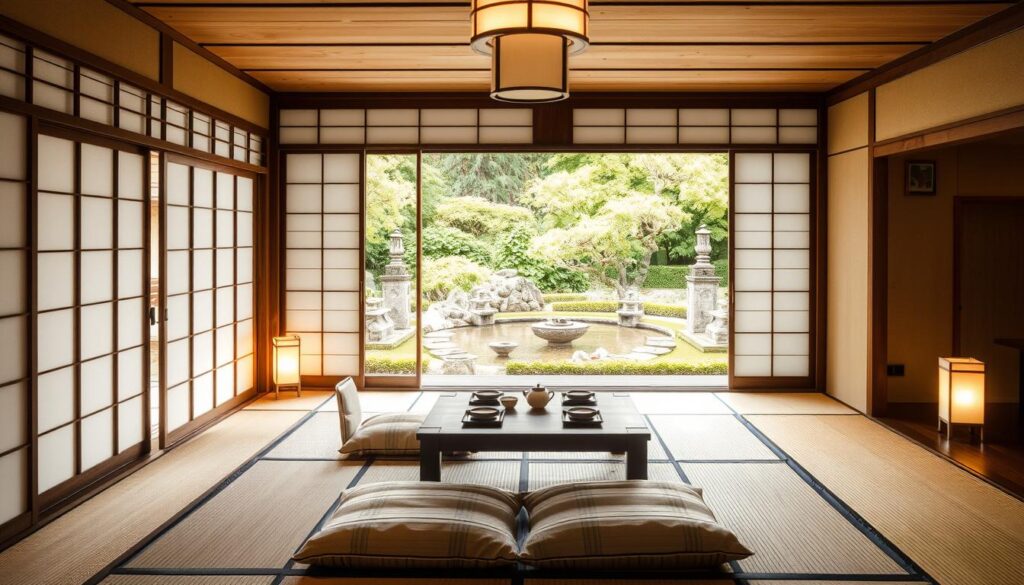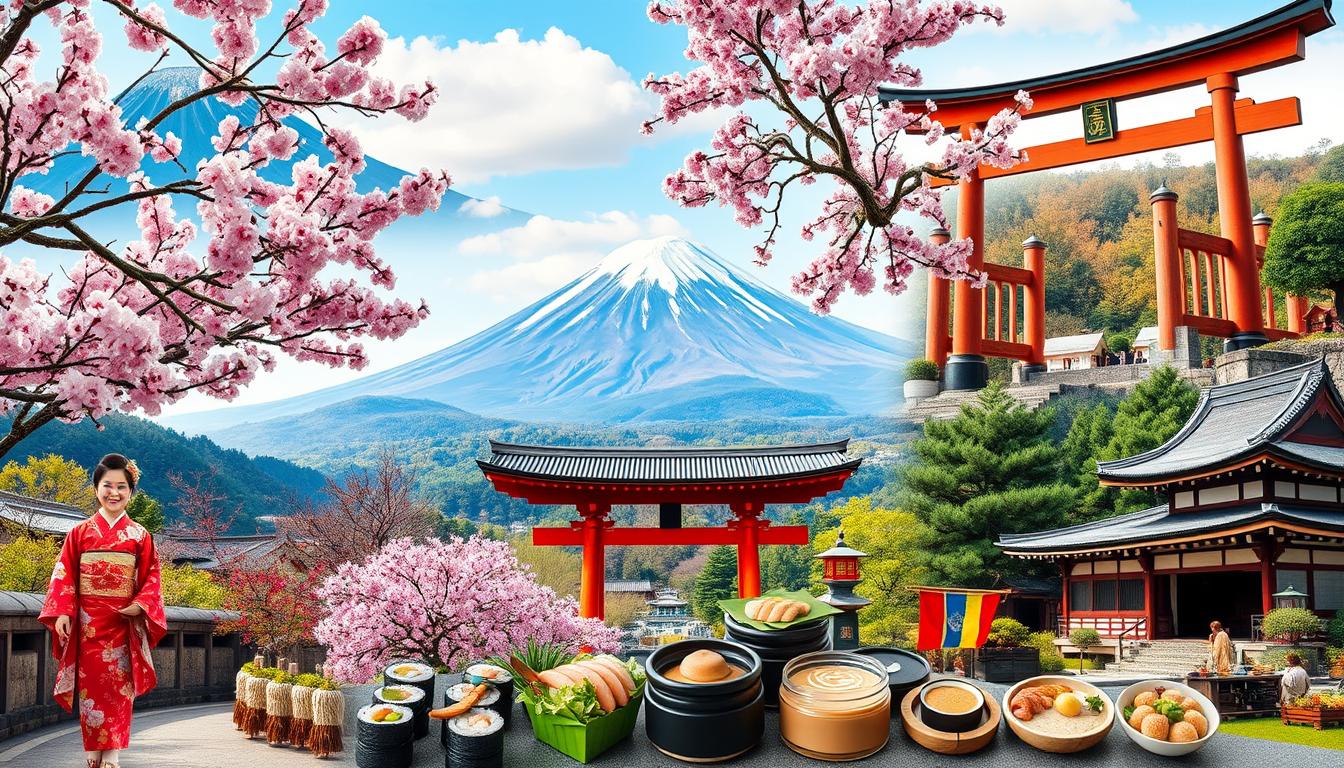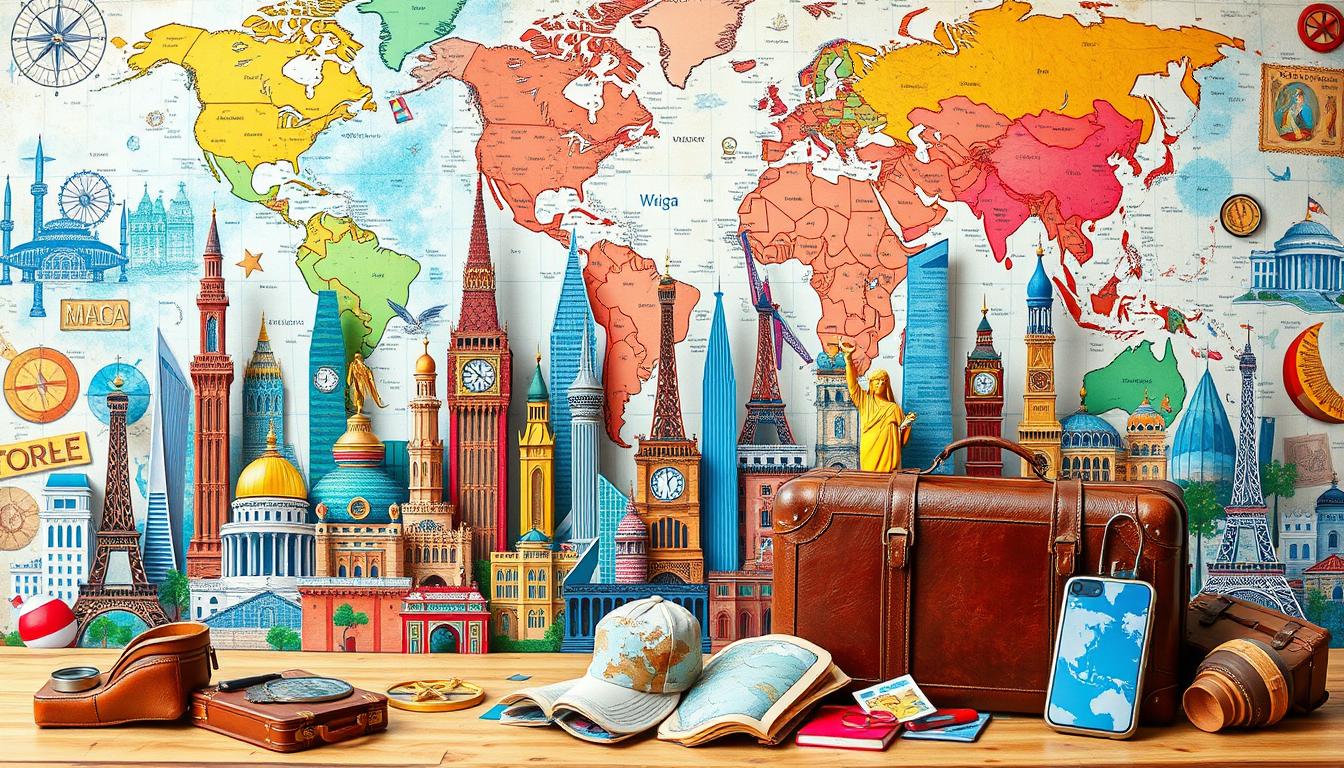Walking through the Arashiyama Bamboo Grove in Kyoto was magical. The tall green stalks moved softly, creating a beautiful light. This peaceful place made me feel like time had stopped.
Japan is a mix of old traditions, stunning nature, and new ideas. Whether you love Tokyo’s bright lights, Kyoto’s calm temples, or Okinawa’s beautiful beaches, there’s so much to see. This guide will help you plan your trip to Japan, so you can make memories that last forever.
Table of Contents
Getting Started: Essential Travel Planning Tips
Planning your dream trip to Japan needs careful thought. You must consider the best time to visit, visa needs, and budgeting. These tips will help make your Japan adventure smooth and memorable.
Best Time to Visit Japan
The best time to visit Japan depends on what you like. Spring, especially from March to April, is great for its beautiful flowers and nice weather. Autumn, in October and November, offers amazing colors.
Summer is warm and full of festivals. Winter lets you see Japan’s snowy beauty and cherry blossom festivals.
Visa Requirements and Documentation
Before your Japan travel guide trip, check your visa needs. Many countries don’t need visas or can get one at the airport. Make sure your passport is good for your stay, with at least six months left.
Budget Planning and Currency Exchange
Creating a budget is key for a great Japan trip. Think about daily costs for places to stay, getting around, and food. Also, plan for any activities or experiences you want. Knowing exchange rates helps you spend wisely. With these tips, you’re ready for an amazing trip to Japan.
Transportation Across Japan
Japan’s landscapes and cities are easy to explore thanks to its great transport network. The Shinkansen bullet train is key, connecting major spots across the country. You can choose from shinkansen bullet train, regional trains, subways, and buses. Japan has many options for every traveler’s needs and budget.
Shinkansen Bullet Train Travel
The shinkansen bullet train shows Japan’s top tech in transport. It goes up to 200 mph, making trips between cities fast. For the best deal, get a Japan Rail (JR) Pass for unlimited JR travel, including the Shinkansen.
Regional Trains and Subway Systems
For local trips, Japan’s regional trains and subways are great. They reach small towns, rural areas, and city centers. This lets you see Japan’s varied landscapes and lively cities.
Budget-Friendly Options
Japan also has cheaper ways to travel, like local buses and coaches. These are good for reaching far places or small cities. They’re perfect for those watching their budget.
| Transportation Mode | Advantages | Considerations |
|---|---|---|
| Shinkansen Bullet Train |
|
|
| Regional Trains and Subways |
|
|
| Local Buses and Coaches |
|
|
Japan’s transport network lets you easily explore the country. You can see tokyo tourism or the countryside’s beauty. Japan has something for everyone, no matter how you travel.

Where to Stay: Accommodation Options in Japan
Japan’s diverse accommodation options are key to a great trip. You can choose from ryokan inns, modern hotels, or capsule hotels. Each offers something special for every traveler’s taste and budget.
Traditional Ryokan Experience
Staying in a ryokan lets you dive into Japan’s culture. These inns have tatami-matted rooms, onsen baths, and kaiseki meals. It’s a chance to truly experience Japan’s traditions, even if it costs more than hotels.
Modern Hotels and Budget Options
Japan also has many modern hotels for all budgets. You can find everything from big chains to small boutiques. For those on a tight budget, there are affordable options like business hotels and hostels.
Unique Capsule Hotels
Capsule hotels are a unique choice in Japan. They offer small, pod-like rooms for a cozy stay. These hotels have shared spaces, making them great for meeting others. They show Japan’s creative side in city living.
No matter if you prefer a ryokan, modern hotel, or capsule hotel, Japan has something for everyone. You’re sure to find the right place for your trip.

Japan Travel Guide: Must-Visit Destinations
Explore Japan’s diverse wonders for your ultimate travel adventure. See Mount Fuji, the Hiroshima Peace Memorial, and Okinawa’s beaches. Each place will amaze you.
Start with the mount fuji hiking challenge. This volcano, at 12,388 feet, offers stunning views. Hike or admire from afar to experience Japan’s beauty.
Then, visit Kyoto for its history and culture. See UNESCO sites like the hiroshima peace memorial. Walk through temples and shrines to learn about Japan’s traditions.
- See the Kinkakuji Temple, or Golden Pavilion, with its golden facade.
- Explore the Fushimi Inari-taisha Shrine with its endless orange torii gates.
- Visit the hiroshima peace memorial for a moving experience.
Finally, go to okinawa beaches for a tropical getaway. Enjoy the sun, swim, and try Okinawan food. The islands have beautiful beaches and a unique culture.
| Destination | Highlights | Ideal Duration |
|---|---|---|
| Mount Fuji | Iconic volcano, hiking trails, panoramic views | 1-2 days |
| Kyoto | Historic temples, shrines, Hiroshima Peace Memorial | 3-5 days |
| Okinawa | Tropical beaches, Okinawan culture, unique cuisine | 2-4 days |
Cultural Experiences and Traditions
Dive into the deep world of Japanese culture on your travels. You’ll find everything from calm tea ceremonies to lively festivals. There’s so much to explore and enjoy.
Traditional Tea Ceremonies
See the ancient art of Japanese tea ceremony, or chanoyu. Watch as a tea master carefully makes and serves matcha green tea. It’s a ritual filled with peace and tradition, tied to samurai heritage and Japanese culture experiences.
Temple Etiquette and Customs
Visit the calm Kyoto temples and feel their spiritual vibe. Learn how to act, like removing shoes before entering. Discover the meaning of rituals like hand purification and ringing the temple bell. These moments let you connect with Japan’s deep religious roots.
Festival Participation Guidelines
- Wear traditional clothes, like a yukata (light summer kimono), to get into the festival spirit.
- Join in on activities like omikoshi (carrying a portable shrine) and taiko drumming. Do it with respect and joy.
- Follow local customs, like making offerings at shrines and dancing together. It’s a great way to connect with Japanese culture experiences.
By diving into these cultural experiences and traditions, you’ll understand Japan’s rich heritage and spiritual side. You’ll make memories that will stay with you forever.
Japanese Cuisine: Food Experiences and Dining Etiquette
Dive into the rich world of Japanese cuisine, where flavors delight your taste buds. Dining etiquette here is an art form. From Tokyo sightseeing streets to the countryside, japanese cuisine is a culinary adventure. Learn about the japanese cuisine guide to understand its unique flavors.
Begin your food journey in Japan’s lively food districts. Walk through tokyo sightseeing markets filled with street food smells. Try yakisoba, takoyaki, and okonomiyaki for a taste of Japan’s flavor mastery.
Explore the diverse japanese cuisine and its regional specialties. Enjoy Edo-style sushi and Hokkaido’s rich ramen. Each dish tells a story of tradition and innovation.
Understanding japanese cuisine etiquette is key. Learn about chopstick use, not mixing dishes, and the importance of seasonality. These customs enhance your appreciation for Japanese food culture.
Japanese cuisine offers both fine dining and home-style cooking. It’s a culinary journey like no other. Let your senses explore the harmony of taste, texture, and tradition.
“The true essence of Japanese cuisine lies not just in the flavors, but in the reverence for the ingredients, the respect for seasonality, and the artistry in presentation.”
Conclusion
This travel guide has given you the tools to plan an amazing trip to Japan. You now know how to get around and dive into the culture. You’re ready for your japan travel guide adventure.
Make sure to see both the new and old sides of Japan. Follow local customs and try the food. With the right mindset, your trip will be unforgettable.
Looking for temples, fast trains, or traditional stays? This guide has you covered. Start your journey with confidence. Japan’s mix of old and new will amaze you at every turn.
FAQ
What are the best times to visit Japan?
What are the visa requirements for traveling to Japan?
How can I budget for my Japan trip and manage currency exchange?
What are the transportation options for getting around Japan?
What are the different types of accommodations available in Japan?
What are the must-visit destinations in Japan?
What are some essential cultural experiences to have in Japan?
What should I know about dining and Japanese cuisine?
Source Links
- The secret to longevity in Okinawa
- Places For Cherry Blossom In Tokyo Japan Creative Travel Guide
- One of Japan’s most awesome rail passes, the Seishun 18 Ticket, just got a lot less awesome
- Le PasSage Brings an All-Star Culinary Lineup to a Stylish Katy Trail Patio
- Hidden Gems for Globetrotters What Are the Best Ways for Travelers to Experience the Northern Lights from Enchanting Glass Igloos in Finland’s Stunning Wilderness? – Travel And Tour World
- How to crowd-proof your vacation in 2025 – The Points Guy
- Global Finals of the 17th Chinese Bridge–Chinese Proficiency Competition for Foreign Secondary School Students Successfully Held in Tianjin
- Data Center IT Equipment Market to Grow by USD 73.6 Million (2024-2028) as Multi-Cloud and 5G Network Upgrades Drive Growth; AI Impact on Market Trends Report – Technavio
- Senior Manager, International Strategy (Disney Entertainment Television) at DISNEY
- Senior Mechanical Engineer at DISNEY
- 14 Decorative Lazy Susans
- 5 things to try on the new Kindle Colorsoft
- Plus Together with TRATON GROUP Brands Scania, MAN, and International Launch Global Release of Level 4 Autonomous Trucking Software in Europe and the U.S. and Move to Next Phase of Commercializing Autonomous Trucks
- HiddenLayer Recognized as a Gartner Cool Vendor for AI Security in 2024
- 10 Must-Try Viral Restaurants in Japan for Food Lovers
- Philippine police arrest suspects in the kidnapping of an American
- Elon Musk’s Criticism of ‘Woke AI’ Suggests ChatGPT Could Be a Trump Administration Target
- The U.S. economy is growing solidly. Here’s what’s working — and what’s not





